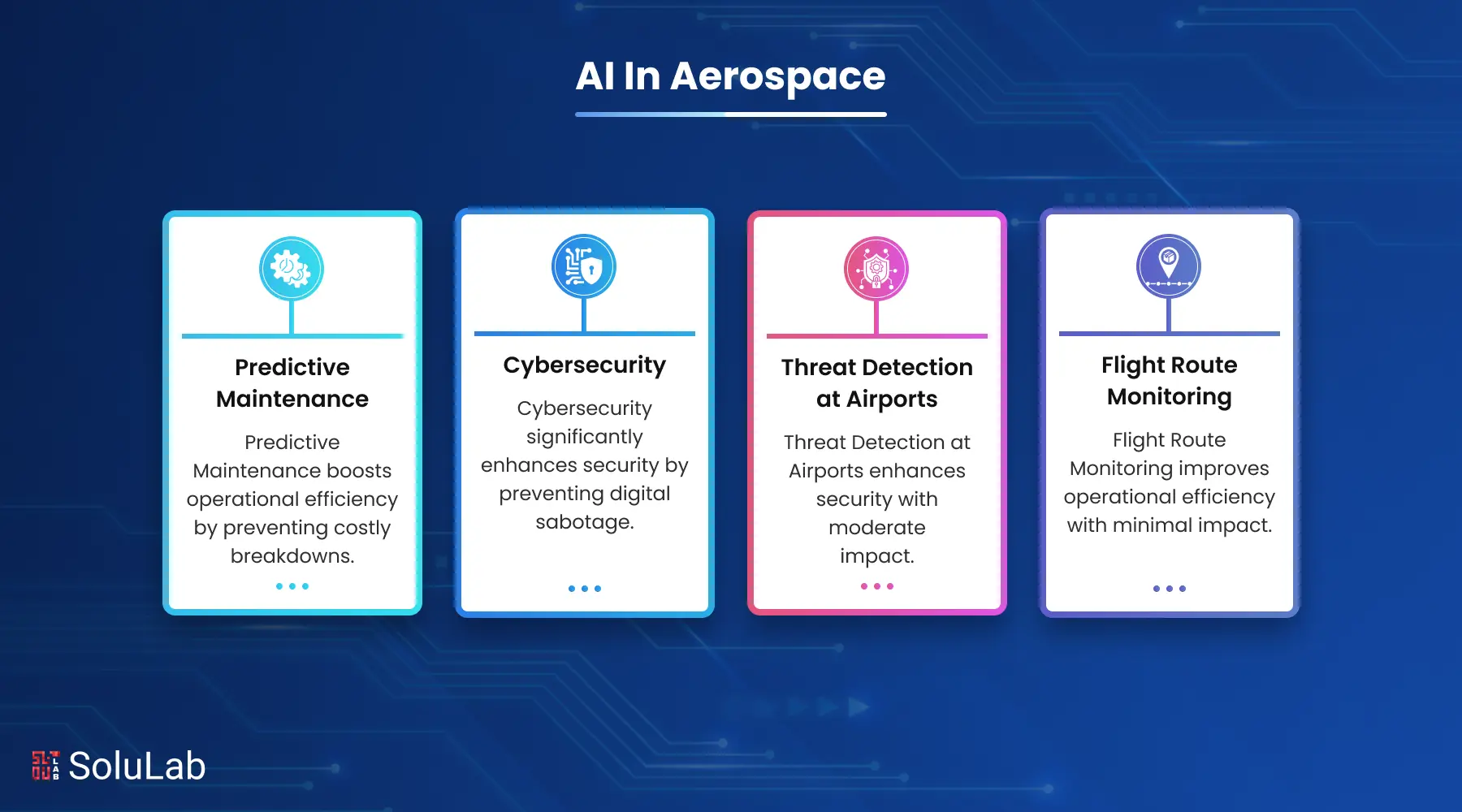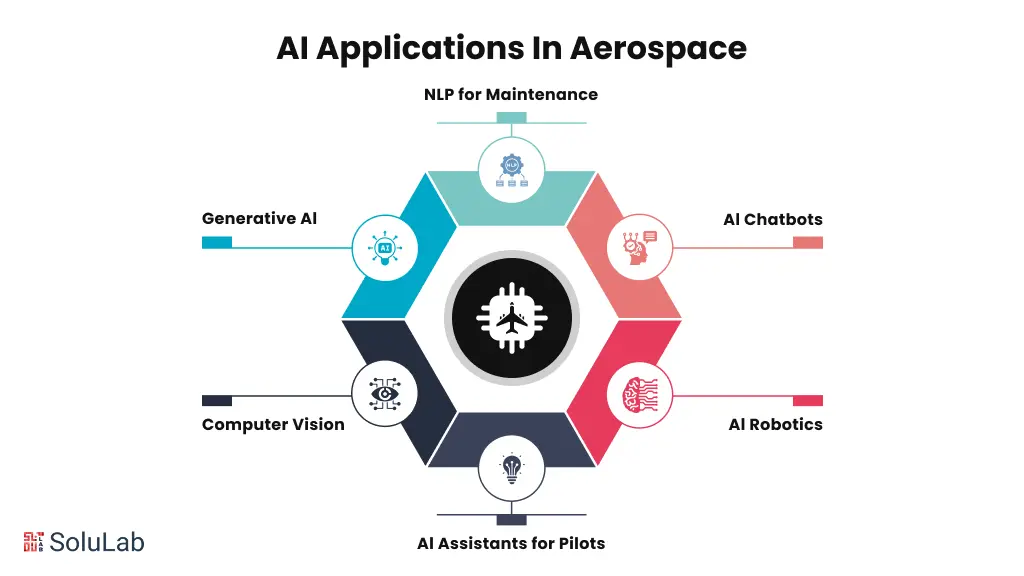
As flight volumes rise and safety becomes more complex, the aviation industry is rapidly adopting AI in aerospace to improve how we fly. From crash prevention to real-time analytics and smart navigation, AI is no longer a futuristic idea; it’s a practical tool driving real results today.
According to McKinsey, AI can help airlines reduce flight delays by up to 30%, cut fuel usage by 12%, and lower maintenance costs by up to 20%. These are not just technical improvements; they directly impact profits, safety, and the passenger experience.
The tragic crash of Air India Flight 171, which took 241 lives, reminded the world of aviation’s high stakes. Incidents like this push the need for predictive systems that can spot problems before they happen. That’s exactly where AI in aviation comes in.
This blog walks you through the integration of AI in aerospace and how it is improving safety and security. Let’s begin!
How Is AI Being Used to Improve Aviation Security?
AI is helping aviation companies make flying safer and more reliable. From aircraft to airport terminals, AI is being used to reduce risks, detect threats early, and protect systems from cyberattacks. AI in aerospace and defense is not a future concept; it is already making a big impact on how the industry runs.
Key Use Cases:
1. Predictive Maintenance
AI finds issues in engines or parts before they cause failures.
- Detects risks using sensor data
- Prevents costly breakdowns
- Keeps aircraft grounded less
2. Cybersecurity
AI protects aircraft and airport systems from hackers.
- Identifies cyber threats in real time
- Secures flight systems and data
- Helps prevent digital sabotage
3. Threat Detection at Airports
Computer vision helps scan passengers and luggage faster and better.
- Finds weapons and suspicious behavior
- Speeds up security checks
- Reduces human error
4. Flight Route Monitoring
AI makes smart decisions during flights to improve safety.
- Suggests safer routes
- Avoids risky airspace or weather
- Reduces the chances of accidents
These are the kinds of AI-powered tools your business can use today. If you’re an airline, defense contractor, or aircraft manufacturer, using AI in aviation is no longer optional; it’s a competitive advantage.
What Types of AI Solutions Can Aviation Companies Use Today?

If you’re running an aviation company, choosing the right AI tools can improve safety, lower costs, and increase efficiency. Below are key AI applications in aerospace that you can start with:
-
Aircraft Inspection
Computer vision helps detect cracks, dents, and wear on aircraft bodies using automated cameras. It also powers facial recognition systems at airports for faster and more secure boarding. This reduces inspection time and human error, making operations more reliable.
-
NLP for Maintenance Reports
Natural Language Processing (NLP) reads maintenance logs and pilot notes to find patterns. It highlights common issues before they become serious and improves technician workflows. This allows faster troubleshooting and reduces unexpected downtime.
-
AI Assistants for Pilots
Real-time AI assistant tools support pilots with alerts and recommendations during critical moments. They help in handling turbulence, system warnings, or weather issues mid-flight. These tools act like a second brain in the cockpit, improving decision-making.
-
Customer Support
AI-powered chatbots handle passenger queries, booking help, and updates without human support. They reduce waiting times, improve customer satisfaction, and save support team costs. Airlines use these bots to manage high passenger volumes during delays or peak hours.
-
Hangar Safety
AI-driven robots carry out visual inspections and routine maintenance in hangars. They’re used for checking landing gear, fuel lines, or cargo holds. This makes safety checks faster, more accurate, and less dependent on manual labor.
-
Generative AI in Aerospace and Defense
Generative AI is used to simulate aircraft design, predict engine damage, and test safety under stress. It reduces the time needed to prototype parts and helps engineers test more ideas quickly. This is especially useful in defense projects that require high performance under strict timelines.
These solutions aren’t one-size-fits-all. You’ll need a reliable AI development company to design, train, and maintain systems that fit your operations.
Can AI Prevent Airplane Crashes and Save Lives?
Yes, it can, and it’s already doing so in many ways. The advantages of AI in aviation are becoming essential for safety teams, airline operators, and maintenance crews. AI helps prevent crashes by detecting problems early, guiding pilots in real time, and improving overall flight safety.
Here’s how AI helps:
1. Predicts Mechanical Failures
With access to past flight and engine data, AI can identify which aircraft parts might fail and when. This allows teams to fix issues before they become dangerous.
2. Supports Pilots with Alerts
AI tools track all flight systems in real-time and can notify pilots of problems, even before warning systems trigger. This gives crews more time to act and prevent emergencies.
3. Prevents Mid-Air Collisions
AI monitors routes and nearby aircraft. It adjusts flight paths to reduce the risk of mid-air collisions, making every flight safer.
After the Air India 171 crash, many experts agree that the application of AI in aerospace could have flagged the hydraulic pressure issue earlier and prevented the tragedy.
How Does AI Improve Aircraft Navigation and Flight Management?

In today’s AI in aviation industry, AI doesn’t just respond to problems, it predicts and improves flight paths before issues happen. Navigation is no longer fixed but flexible and smart:
- Flight Path Optimization: AI calculates the best routes and altitudes to save fuel and reduce flight time. This helps airlines cut costs and be more efficient.
- Turbulence Avoidance: AI analyzes weather patterns in real time to warn pilots about rough air ahead, making flights smoother and safer.
- Autonomous Navigation Systems: These AI-driven systems lay the groundwork for future pilotless planes, helping with safe and reliable autopilot features.
Many leading AI aerospace companies in the USA are investing in these smart AI solutions to boost safety and operational efficiency.
What Role Does AI Play in Real-Time Aviation Analytics?
In the past, aviation analytics were used after something happened. Today, thanks to real-time AI, airlines and aerospace companies can act before problems occur. AI now processes huge amounts of data from aircraft sensors, air traffic systems, and weather reports, live, as it happens. This helps decision-makers spot issues early and respond quickly.
Here’s how AI in aerospace engineering is used in real-time analytics:
1. Real-Time Alerts: AI sends instant warnings when something is wrong, like engine pressure drops or temperature spikes.
2. System Performance Reports: It continuously tracks how every system is performing, helping teams make smarter decisions.
3. Maintenance Forecasting: AI can predict when a part might fail, so it can be replaced before it causes delays or safety issues.
For large aviation businesses, real-time AI analytics are no longer optional. They help improve safety, reduce costs, and avoid downtime. Many AI aerospace companies in the USA are already investing in these tools to stay ahead of the competition.
What Is the Future of AI in Aerospace and Aviation Safety?
The future of AI in aerospace industry is full of opportunity. Over the next decade, aviation companies will see major shifts as they adopt more AI-powered systems designed to make flying safer, smarter, and more efficient.
Here are some key trends shaping the future:
1. Autonomous Flights
Pilots will act more like supervisors, while AI handles basic flight operations and decision-making in real time.
2. Generative AI in aerospace and defense
AI will help design and simulate aircraft parts, test flight scenarios, and predict maintenance needs before a problem occurs.
3. Cybersecurity with AI
As planes and airports get more connected, AI will protect communication systems and critical software from cyber threats.
4. AI Agents for Air Traffic Control
AI-powered systems will assist human controllers by predicting traffic congestion and avoiding mid-air conflicts.
These trends show that AI in aerospace companies is already preparing for a smarter future.
How Can Our AI Development Company Support Aerospace Businesses?
As a trusted AI development company in the USA, SoluLab doesn’t just create software; we build practical AI tools that solve real problems for aviation and aerospace companies.
Here’s how we can help:
1. Custom Predictive Maintenance Tools
We develop AI systems that detect possible aircraft issues before they happen, helping prevent delays and reduce risks.
2. Integration with Existing Aviation Systems
We connect new AI features with your current software and hardware, so you can upgrade your operations without replacing everything.
3. Complete Development
From airport security to flight navigation, we offer full-stack AI application solutions tailored to your operations.
Whether you’re managing flights, inspections, or passenger experiences, we help you harness AI to improve safety, cut costs, and scale faster. As a team of specialized experts, SoluLab allows businesses to hire AI developers to build or integrate custom AI systems in existing operations for easy and quick results.
We don’t just offer tech, we offer solutions that help your teams operate smarter. Contact us today!
FAQs
1. What role does AI play in aerospace engineering in modern aircraft?
AI in aerospace engineering supports design, testing, and real-time system monitoring. Engineers use AI tools to simulate performance, reduce material waste, and build smarter aircraft systems that adapt in-flight based on changing conditions.
2. Why is AI in aerospace and defense important for national security?
AI in aerospace and defense helps monitor airspace, detect threats faster, and manage complex systems like drones or autonomous aircraft. Defense contractors use AI to build more secure and responsive aviation infrastructure.
3. How is generative AI in aerospace and defense transforming the industry?
Generative AI in aerospace and defense is used to create real-time simulations, generate design prototypes, and predict possible system failures. It speeds up R&D cycles and helps teams respond to new challenges with data-driven insights.
4. How does AI in aerospace manufacturing improve production quality?
AI in aerospace manufacturing automates repetitive tasks, improves quality control, and reduces production time. It helps identify defects early, increases productivity, and ensures aircraft parts meet strict safety standards.
5. Who are some leading AI aerospace companies in the USA?
Many AI aerospace companies in the USA offer innovative solutions for flight analytics, autonomous drones, and aviation security. Firms like Boeing, Lockheed Martin, and startups in Silicon Valley are leading the charge in AI integration.
6. Why are more AI in aerospace companies investing in custom solutions?
AI in aerospace companies is investing in custom tools to stay competitive. With custom AI solutions, they can improve efficiency, automate complex tasks, and meet strict compliance and safety standards more easily.





